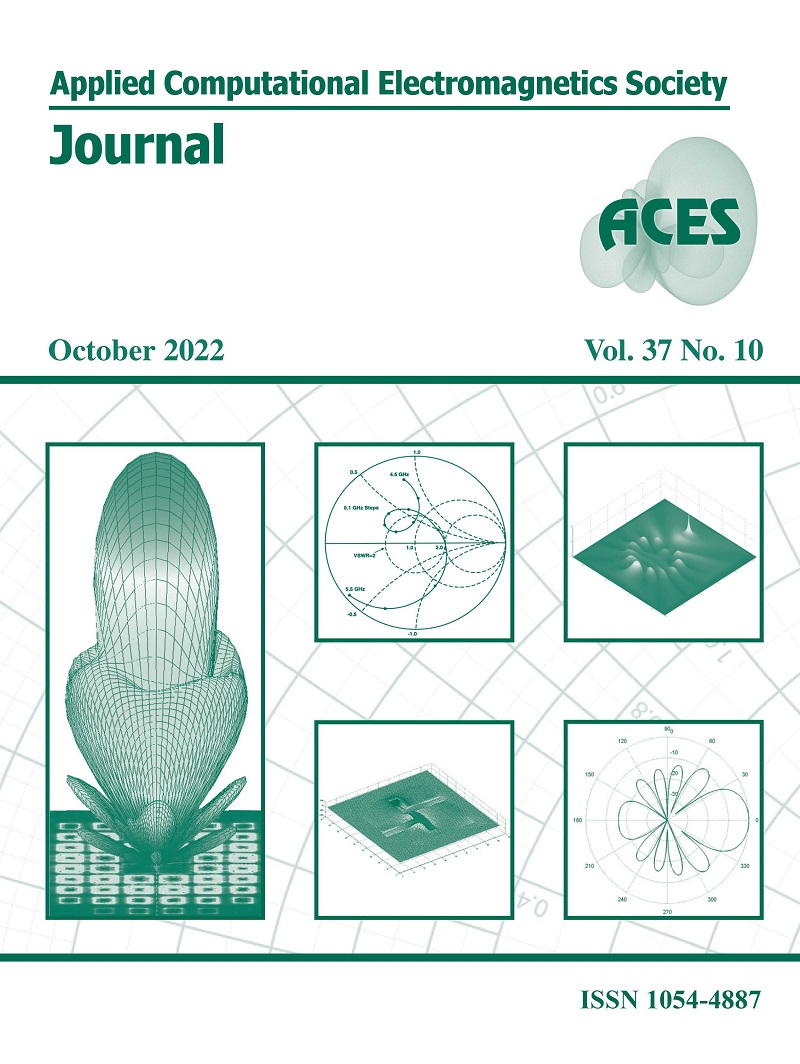A Topological Charge Continuously Tunable Orbital Angular Momentum (OAM) Electromagnetic Wave Generation Method Based on Fixed-length Delay Line Mixing Circuit
DOI:
https://doi.org/10.13052/2022.ACES.J.371007Keywords:
beam steering, continuous topological charge, delay line, vortex electromagnetic wavesAbstract
To overcome the drawback of complex structure and high cost attributed from the utilization of phase shifters to generate OAM in the conventional schemes, this paper proposes a new method for generating OAM based on a fixed delay line. By deriving the proposed system with fixed delay line theoretically, the relationship between the frequency of the input signal on the delay line and the topological charge of the OAM is obtained, and the topological charge of the generated OAM can be controlled by controlling the frequency. Furthermore, this paper proposes a vortex beam pointing control method based on phased array scanning, so as to realize the beam steering of OAM. It is then verified by using electromagnetic simulation, and the simulation results show that the proposed method is feasible. The proposed method not only has the advantages of simple structure and low cost, but also can generate OAM with continuously adjustable topological charge by controlling the frequency, which has the functions of topological charge reconstruction and dynamic adjustment.
Downloads
References
L. Allen, M. W. Beijersbergen, R. Spreeuw, and J. Woerdman, “Orbital angular momentum of light and the transformation of laguerre-gaussian laser modes,” Physical Review A, vol. 45, no. 11, pp. 8185, 1992.
L. Allen, M. Padgett, and M. Babiker, “IV the orbital angular momentum of light,” Progress in Optics, vol. 39, Elsevier, pp. 291-372,1999.
A. M. Yao and M. J. Padgett, “Orbital angular momentum: origins, behavior and applications,” Advances in Optics and Photonics, vol. 3, no. 2, pp. 161-204, 2011.
B. Thidé, H. Then, J. Sjöholm, K. Palmer, J. Bergman, T. Carozzi, Y. N. Istomin, N. Ibragimov, and R. Khamitova, “Utilization of photon orbital angular momentum in the low-frequency radio domain,” Physical Review Letters, vol. 99, no. 8, pp. 087701, 2007.
H.-T. Chen, Z.-Q. Zhang, and J. Yu, “Near-field scattering of typical targets illuminated by vortex electromagnetic waves,” Applied Computational Electromagnetics Society (ACES) Journal, pp. 129-134, 2020.
A. E. Willner, H. Huang, Y. Yan, Y. Ren, N. Ahmed, G. Xie, C. Bao, L. Li, Y. Cao, Z. Zhao, J. Wang, M. P. J. Lavery, M. Tur, S. Ramachandran, A. F. Molisch, N. Ashrafi, and S. Ashrafi, “Optical communications using orbital angular momentum beams,” Advances in Optics and Photonics, vol. 7, no. 1, pp. 66-106, 2015.
O. Edfors and A. J. Johansson, “Is orbital angular momentum (oam) based radio communication an unexploited area?,” IEEE Transactions on Antennas and Propagation, vol. 60, no. 2, pp. 1126-1131, 2011.
Y. Liu, Y. Zheng, Q. Feng, and L. Li, “Orbital angular momentum mode spectrum analysis of multi-uca antenna for generating vortex electromagnetic wave,” International Conference on Microwave and Millimeter Wave Technology (ICMMT), IEEE, pp. 1-3, 2018.
V. Vaishnavi, V. Priya, M. Kumar, S. Venkatesh, and S. G. A. Shanmugha, “Simulation of helical modulation in a focal plane array,” in: 2014 International Conference on Communication and Signal Processing, IEEE, pp. 1414-1418, 2014.
F. E. Mahmouli and S. D. Walker, “4-gbps uncompressed video transmission over a 60-ghz orbital angular momentum wireless channel,” IEEE Wireless Communications Letters, vol. 2, no. 2, pp. 223-226, 2013.
M. Klemes, H. Boutayeb, and F. Hyjazie, “Orbital angular momentum (oam) modes for 2-d beam-steering of circular arrays,” IEEE Canadian Conference on Electrical and Computer Engineering (CCECE), IEEE, pp. 1-5, 2016.
H.-T. Chen, R. Pan, W.-Z. Sun, and S.-Y. He, “Microstrip reflectarray for generation of electromagnetic waves with beam vorticity,” Applied Computational Electromagnetics Society (ACES) Journal, vol. 33, no. 5, pp. 488-493, 2018.
T. Yuan, Y. Cheng, H.-Q. Wang, and Y. Qin, “Generation of oam radio beams with modified uniform circular array antenna,” Electronics Letters, vol. 52, no. 11, pp. 896-898, 2016.
J. Rao, G. Trunk, and D. Patel, “Two low-cost phased arrays,” IEEE Aerospace and Electronic Systems Magazine, vol. 12, no. 6, pp. 39-44,1997.
B. Avser, J. Pierro, and G. M. Rebeiz, “Random feeding networks for reducing the number of phase shifters in limited-scan arrays,” IEEE Transactions on Antennas and Propagation, vol. 64, no. 11, pp. 4648-4658, 2016.
D. Ehyaie and A. Mortazawi, “A new approach to design low cost, low complexity phased arrays,” IEEE MTT-S International Microwave Symposium, IEEE, pp. 1270-1273,2010.
T. Yuan, Y. Cheng, H. Wang, and Y. Qin, “Beam steering for electromagnetic vortex imaging using uniform circular arrays,” IEEE Antennas and Wireless Propagation Letters, vol. 16, pp. 704-707, 2016.
Q. Feng, Y. Lin, Y. Zheng, and L. Li, “Vortex beam optimization design of concentric uniform circular array antenna with improved array factor,” Applied Computational Electromagnetics Society (ACES) Journal, vol. 36, no. 7, pp. 830-837, 2021.




